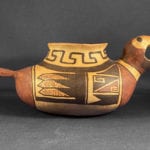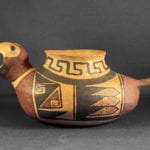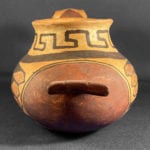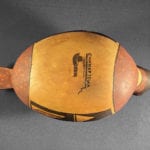The beak is 2″ long and the tail is 1.5″ long.
This is a prehistoric Sikyatki polychrome effigy vessel of a macaw parrot. Except…
…Except it is was made about 30 years ago by a White man. Other than that — its clay, form, paint, technique of manufacture and firing— it is an absolutely authentic Sikyatki pot. The maker, Michael Hawley (1948-2012), was trained in Hopi pottery techniques by a member of the tribe, who also gave permission for him to collect materials, form and fire his pots on the reservation near the ancient village of Sikyatki. During the 1970’s and 1980’s his pottery was carried by major Scottsdale galleries and sold for impressive prices. He signed his pots “Chakoptewa,” an adopted Hopi name.
Since the 1870’s most pottery at Hopi has been made for sale to outsiders. Over the years this has led to an increasing perfection of finish and design desired by collectors. Prehistoric potters formed and painted their pots according to local standards and thus their pottery has a different look and sensibility than modern Hopi pots. Although his pots were also intended to be sold to the Anglo art market, Hawley adhered to ancient standards, not modern sensibilities, giving his pottery a rough boldness and spirit not otherwise seen on Hopi pottery.
The form:
Macaw effigy 2019-06 has a fairly thick bottom, substantial walls and a tail and neck that are solid clay, giving the vessel substantial heft. The inside of the lip is stone polished but is also dimpled by the fingers of the maker. The tail is severely linear and grooved, in contrast to the other elements of the body that are all rounded. The eyes and beak are pushed out from the inside of the head. Like the two similar ancient effigies I have found (see below), the beak is open, sharp and threatening. The tongue is visible; this bird is speaking with a loud squawk.
The design:
The head is painted with a muddy red paint, except for the eyes and beak. Protruding eyes display a solid black pupil. The red head has a thin, black framing line. The exterior of the rim is unpainted except for a meandering squared-off greek key. Below is a thick framing line with a spirit break at the neck. This unpainted break extends around the neck and visually distinguishes the head from the rest of the body. Below the chest of the bird is painted muddy red.
Beneath the thick framing line are two panels of design, almost exactly the same on both sides of the bird. At the center of the leading edge of the front panel is a black square. The square is bisected to form an upper black triangle and a lower red triangle. These triangles are solid except that interior at the right angle of each is a small largely unpainted square incorporating a greek key. The black version has four 90-degree turns, the red key is smaller with just two 90-degree turns. On the bird’s left flank the black key starts from the rear and moves forward; on the right flank this key starts from the front and grows to the rear. This small detail is the only difference of design between the two sides of the figure.
Above and below this central design are two black forms that fill the residual areas. Above the form is a triangle with its hypotenuse curved to conform to the framing line. Below is a notched rectangle, its lower point extended to the right across the otherwise unpainted right quadrant of this panel.
A black line separates the front panel of design from the rear panel.
The rear panel consists of three adjoining linear feathers set on a black base. The base extends slightly beyond the row of feathers, its central portion rises up into three right triangles. The three feathers incorporate these black triangular forms, their residual space is filled with stippled black paint. Since stippling is said to represent rain and feathers carry the prayers of the people to the Creator, this combination of form and paint has significant meaning.
Two black lines separate this rear panel of design from the remaining section of the bird.
From this point to the tip of the tail, the bird is painted with the splotchy red paint. Thus a viewer’s eye sees the front and rear of the bird as large patches of red with the central panels of design mostly black. This is a balanced bird.
On the bottom the vessel is marked “Chakoptewa” and the inscription “88 V 8,” which I believe indicates that it was made in 1988 on the 8th of month “V,” the meaning of the V is uncertain but may be the 5th month of the year: May.
The Maker:
Hawley did not use modern methods to recreate ancient pots. Instead he “became Sikyatki,” as a fine actor might become his role. I have a video of him dressed as he imagined an inhabitants of Silyatki 500 years ago, using tools of his own manufacture and using found materials to build his ”Chakoptewa Polychrome” pots. Like Sikyatki potters, but unlike modern Hopi or Hopi/Tewa potters, he fired with local coal, not dung.
Al Anthony Jr., of Adobe Gallery in Santa Fe, NM, sells pottery by Mike Hawley and his description, reprinted here, captures the unique niche that this pottery occupies in a typology of Southwest Native ceramics:
“Michael Hawley of Scottsdale, Arizona is the only… potter … creating true Sikyatki Polychrome pottery in the same manner as they were originally made from the 14th through the 17th centuries. Hawley calls this pottery “Chakoptewa Polychrome,” Chakoptewa being his adopted Hopi name. Hawley uses only hand-ground clay dug on Antelope Mesa on the Hopi Reservation and he hand coils, shapes, polishes paints and coal fires each of these pots in a firing pit he constructs himself. All of his pigments are made by hand from minerals and plants indigenous to the Hopi Mesas and each of his painted designs is original and within the Sikyatki design tradition. Mike Hawley’s pieces are original and unique pieces of contemporary ceramic art inspired by ancient tradition. They are not copies or replicas.
Prehistoric examples of this Macaw parrot form are rare but not unknown. I have found four published examples. The first was excavated from the ancestral Hopi village of Homol’ovi and is part of the collection of the Field Museum, Chicago (No. A114268, catalog number 72564). It was published twice: a) in the Fall 2006 issue of Plateau by the Museum of Northern Arizona (Vol. 3, No. 1: 17) and b) in a wonderful MNA book Painting the Cosmos (Hays-Gilpin, Newsome and Sekaquaptewa, 2010:128).
The second published example is part of the Cooke Collection now at the Museum of the West in Scottsdale, AZ. (Wade and Cooke, 2012:74-75). This bird is was formed about 1500CE to 1550CE, but no other provenance is given.

Cooke bird effigy
A third example was published in 1903 in the Annual Report of the Board of Regents of the Smithsonian Institution. An article by Walter Hough reports on “Archeological Field Work in Northern Arizona” in 1901. Plate 94 shows a “Vase of Parrot Form” excavated from the prehistoric site of Kawaiokuh. The vessel has the same general form as 2019-06 (minus the tail) but seems to be painted monochromatic black on a light beige background. The design is less complicated than the two examples already cited or the version by Michael Hawley discussed here. A fourth bird effigy pot excavated at Awatovi has a very different form (Fewkes, 1898: plate CXII #c following page 620).
“The creation of small pottery birds figurines appears to have been customary at Awatovi at all periods during its occupation, for specimens in that form were found in all the major pottery types. They were never numerous… The function of these vessels is not established (Watson Smith, 1971:142-143 and 414-415).”
Parrots were the most frequently depicted birds in the kiva murals of Awatovi and Kawaika-a (Watson Smith, 1952: 183-187). Jake Koopee adapted these images in designing vase 2013-08 in this collection and a review of ancient depictions of macaw parrots can be found in that entry. Macaws were never native to Arizona but were traded alive from Central America and laboriously carried north, though perhaps they were later bred in Arizona to provide a local source.
Rachael Sahmie was inspired by the first of these ancient examples to produce a series of similar pots, one of which is part of this collection (2016-09). Rachael’s work has all the characteristics of Sikyatki Revival pottery and is lovely. In contrast, pot 2019-06 in this collection has a more raw and powerful spirit, like the first two prehistoric examples cited above.
Recently pottery by Bobby Silas has reached the market. As near as I can tell Bobby is making modern Sikyatki pottery that uses ancient designs and coal firing. Unlike Michael Hawley, he is Hopi. This collection has one of his pots, 2019-11.








